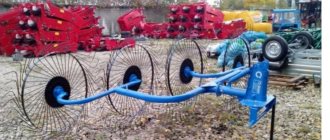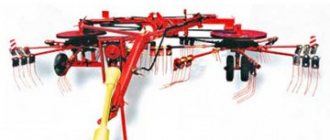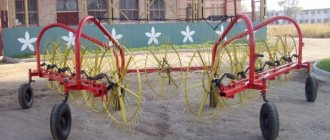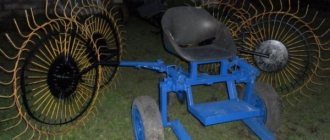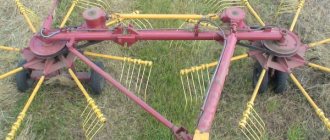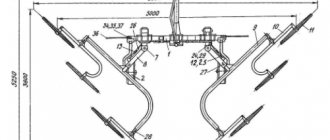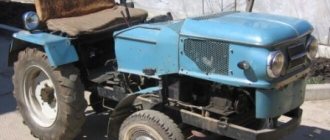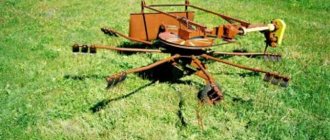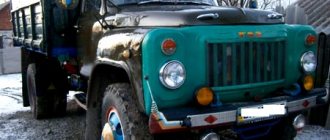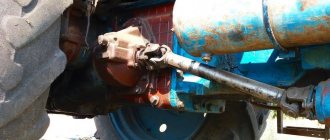A tractor rake is an indispensable thing when collecting hay. Due to the manufacturing features and ease of use, rakes and tedders quickly collect hay using a tractor or walk-behind tractor. Actually, there is no significant difference between rakes and tedders. Their main purpose is to rake up the mown grass and collect the finished product. Mounted rakes/tedders for the tractor can be purchased at a specialized store or made with your own hands.
Description
This turner attachment is designed to perform two tasks:
- tedding hay;
- raking it to one side.
The working part of this type of tractor-mounted equipment (Russian, Finnish, Polish or Turkish) in most cases consists of four or five wheels. They all rotate in the same direction in a plane that is perpendicular to the direction of movement of the mini tractor.
In this case, the outermost wheel is slightly ahead of the others, the second is slightly behind, the third is even further, then the fourth and fifth. They all rotate in the same direction.
Each wheel has many metal rods around its perimeter, which are slightly curved at the edge in the shape of a hook.
Tedder rake
In raking mode, work occurs as follows.
The wheels, according to the instructions, rotate in such a way that the very first wheel, located on the right (if you face the direction of movement), picks up the hay scattered on the surface of the ground with metal rods and throws it to the side so that it falls under the second wheel. Then in exactly the same way he throws it under the third, then under the fourth, then under the fifth. The last wheel throws the hay to the left, where it, having been collected from the entire working strip of the rake-tedder, is folded into one row.
There are several options for working:
- You can make one pass, then in the opposite direction, so that all the hay ends up in one row, where it will be much easier to collect.
- You can make three passes in one direction, gradually moving the collected hay in one direction. In this case, you will have to collect three times as much hay from one row.
There are other possible operating schemes that can be followed on the tedder rake in this mode.
In the tedding mode, the tractor driver rotates the frame with impellers 180 degrees. In this case, the rightmost wheel will be located at the rear. The hay he picks up will not fall on other wheels. The same can be said about each of the wheels.
Tedder rake at work
Instructions for the wheel-finger rake-tedder “Breadwinner”
Instructions
WHEEL-FINGER RAKE-TEDDER
"BREADWINNER"
1. INTRODUCTION
These operating instructions should be considered an integral part of the equipment.
The operating instructions are included in the basic equipment delivery package.
The supplier of equipment - both new and used - must submit the documentation required by these instructions along with the equipment.
Before starting work, the buyer must read these instructions, which clearly describe all issues related to the proper use and maintenance of this equipment. The operation and maintenance instructions are intended to familiarize the user of the rake-tedder on the following issues:
- correct operation, safe operation rules.
If the instructions contain information that is incomprehensible to the user, he can obtain comprehensive explanations on all issues of interest to him from the equipment manufacturer or at the point of sale of the equipment. This instruction manual uses a warning symbol with an appropriate description to highlight information regarding potential hazards:
If you see this sign, you should be aware of the possible danger and carefully read the information provided, as well as inform other operators about this.
Compliance with the manufacturer's recommendations contained in these instructions guarantees the user satisfactory results when working with the tedder rake.
2. PURPOSE OF RAKE-TEDDERS
Rake-tedders are designed for tedding mown low-stemmed plants (grass, alfalfa, clover), which are dried on the field, as well as for raking already dry hay into oblong shafts. A tedder rake can also be used to rake up crop residues such as straw after harvesting. Rake tedders can be used on fields and meadows with a slope of no more than 12 degrees, in the absence of large stones, uneven surfaces and other unmarked obstacles.
3. SAFE WORKING CONDITIONS
To prevent accidents and injuries when servicing mounted rakes, the following recommendations must be strictly adhered to:
— servicing of the rake-tedder should only be entrusted to an experienced tractor driver who has read the operating instructions;
— all work related to adjustment and repair work can only be carried out with the tractor engine turned off and the device lowered;
— during transportation on roads, the speed should not exceed 15 km/h;
— when driving on a poor-quality surface, the speed should be reduced accordingly;
— no persons are allowed to remain on the rake-tedder during operation;
— rakes should be stored in a place that excludes the possibility of injury to people or animals;
— during prolonged downtime, the rake-tedder should be lowered to the ground.
All actions related to removing blockages and cleaning equipment must be carried out after the equipment has been lowered to the ground, with the engine turned off.
DANGERS:
- you should be careful about the protruding rods of the rake-tedder wheels - there is a possibility of injury
- precautions must be taken when performing any actions near the wheels of the tedder; during transportation, the equipment protrudes significantly beyond the tractor on the right side; it is necessary to take into account the behavior of the equipment when maneuvering the tractor
4. INTENDED USE OF THE EQUIPMENT
Rake tedders are trailed equipment intended exclusively for use in agriculture or similar work. Use of the equipment for other purposes is considered improper use. Compliance with and strict adherence to the operating conditions contained in these instructions is also an integral element of the requirement that the equipment be used for its intended purpose. Maintenance and repair of equipment may only be carried out by persons who have read the operating instructions. In all circumstances, accident prevention guidelines and all basic safety and traffic regulations must be observed. Unauthorized changes to the design of the equipment may become the basis for releasing the manufacturer from liability for damage or injury.
5. DELIVERY METHOD AND EQUIPMENT
The buyer receives mounted rake-tedders disassembled and not prepared for use.
Tedder rakes have non-powered tedder wheels that are raised or lowered by a hydraulic lift. The working elements of the device are the spring pins of the tedder wheels. The fingers of the tedder wheels should lightly touch the stubble during operation, while the springs on the frame should be properly tensioned.
The device should be connected to the tractor using a rod and a hydraulic lift.
The terms of the warranty are contained in the warranty card, which the buyer receives along with the operating instructions at the point of sale when purchasing the equipment.
6. EQUIPMENT OPERATION – RAKING
Before starting work, you should check the general condition of the tedder rake. All nuts should be tightened and the condition of the cotter pins should be checked. The impeller hubs should be injected using Litol-24 lubricant. The tedder rake prepared in this way should be hung on the tractor and leveled.
ATTENTION! Make sure that the locking bar blocking the tedder arm has been removed!
RAKING (Fig. 1)
Place the unit on a flat plane Check all parts of the unit connection Attach the unit at three points to the tractor's attachments and insert the pins (bolts) Attach the bending part of the frame at the level of the left wheel of the tractor and insert the pin (bolt) Attach the bending part of the axles at the level of the left wheel of the tractor and insert the pin (bolt) and install the raking wheels in the position shown in Figure 1,
The correct position of the rake device is shown in Figure 1
Raise the tedder using a hydraulic lift to a position that allows the rake wheels to turn around. To achieve the required position:
* Move the attack angle adjustment finger to
the correct hole.
* Move the rake wheels to the working position using a hydraulic lift so that the spring fingers of the rake wheels easily touch the stubble.
Figure 1. Rake position for raking
When raking, the operating speed cannot exceed 8.5 km/h. It is recommended to carry out raking in a driven manner.
7. OPERATION OF EQUIPMENT – TERDERING
Before starting work, you should check the general condition of the tedder rake. All nuts should be tightened and the condition of the cotter pins should be checked. The impeller hubs should be injected using Litol-24 lubricant. The tedder rake prepared in this way should be hung on the tractor and leveled.
ATTENTION! Make sure that the locking bar blocking the tedder arm has been removed!
TEDING
Place the unit on a flat plane Check all parts of the unit connection Attach the unit at three points to the tractor's attachments and insert the pins (bolts) Attach the bending part of the frame at the level of the left wheel of the tractor and insert the pin (bolt) Attach the bending part of the axles at the level of the left wheel of the tractor and insert the pin (bolt) move the tedder wheels into working position using a hydraulic lift so that the spring pins of the tedder wheels easily touch the stubble
Correct position of the device for
tedding is shown in Figure 2.
To achieve the required position
follows:
- raise the tedder using a hydraulic lift to a position that allows the rake wheels to turn around; move the angle adjustment pin
attacks into the desired hole
- turn the rake wheels into working mode
position using hydraulic
lift so that
spring tines of the rake wheels are easy
touched the stubble.
Figure 2. Position of rake for tedding.
When tedding, the working speed should not exceed 12 km/h. Tedding is carried out by circular passages of rakes.
RECOMMENDATIONS FOR SAFE SWITCHING OF EQUIPMENT
- In order to safely switch equipment from tedding to raking or vice versa, you should: Remove the locking pins Stand facing the large lever of the rake wheels No. 2 Rotate the large lever 2 together with the rake wheels 180°, Install the locking pins
It is forbidden to switch equipment while holding the rake wheels with your hands.
Table 1. List of lubrication areas.
| Position on | Site name | Frequency (hours | Quantity | Type of lubricant |
| drawing | lubrication | work) | plots | |
| 1 | Bearings | 300 | Litol 24 | |
| rake wheels |
9. PRESERVATION AND STORAGE
Upon completion of work, the tedder rake should be thoroughly cleaned and inspected to detect possible damage. Damaged fingers should be replaced with new ones. If play is detected in the rake wheels, the bearings should be replaced. At the end of the agricultural work season, lubricate all working surfaces. The device should be stored under cover.
10. TRANSPORTATION ON PUBLIC ROADS
Mounted tedder rake, prepared for transport (raking position).
The speed must be consistent with actual traffic conditions and restrictions. The device must not be transported at speeds exceeding 15 km/h.
It is the user's responsibility to equip the rake when driving on public roads with signs and light signals, in accordance with current traffic regulations.
- white side lights, forward-facing combination lights (turn signal, side markers, stop sign) and rear-facing reflectors (red triangles).
The manufacturer can equip the rake-tedder with additional means solely upon additional order of the buyer.
| 11. TECHNICAL CHARACTERISTICS | ||||
| Parameter | 4 wheels | 5 wheels | ||
| Working width: | ||||
| tedding | 3 | m | 3,5 | m |
| raking | 2,5 | m | 3 | m |
| Working speed: | ||||
| tedding | up to 12km/h | up to 12km/h | ||
| raking | up to 8.5 | km/h | up to 8.5 | km/h |
| Transport speed | up to 15km/h | up to 15km/h | ||
| Impeller diameter | 1.5m | 1.5m | ||
| Actual performance: | ||||
| tedding (at a speed of 9 km/h) | approx. 2ha/h | approx. 2.5 ha/h | ||
| raking (at a speed of 7 km/h) | approx. 1ha/h | approx. 1.3 ha/h | ||
| Device weight | 165 | kg | 195 | kg |
| Service | tractor driver | tractor driver | ||
| Tractor power | 18 | 20 | ||
| Number of springs on the disk | 40 | 40 |
12. Manufacturer's warranty
When filing a complaint, you must present the warranty card. The warranty covers defects and damage caused by the manufacturer, due to defects in material, poor quality processing or assembly.
The buyer of the rake-tedder receives a guarantee for a period of 12 months.
The terms of the warranty are specified in the warranty card, which, together with the operating instructions, is issued at the point of sale of the equipment.
Manufacturer: , Izhevsk, .
13. WARRANTY CARD
Buyer______________________________________________________________
Date of sale:___________________
This warranty is valid for 12 months from the date of purchase
devices, that is, up to ______________________________________________________________
(signature of the seller and seal of the point of sale)
I have read the instructions ___________________________________________ (full name and signature of the buyer)
Advantages
This technique (for example, GVK rake or Harvest rake) can be used to achieve the following goals:
- After mowing, dry grass is located on the field chaotically, randomly. In order to collect hay, it needs to dry well. Here tedding can be used using such a hitch.
- If the hay has already been collected in rows, sometimes you need to give it the opportunity to dry additionally. To do this, you can use trailed rakes to wrap the rows or simply scatter them.
- The mowed grass can be raked into neat rows so that it is convenient to collect the hay after it has dried thoroughly.
- When the hay has already been collected into windrows, it sometimes makes sense to combine two or more rows into one. This can also be done using a wheeled rake.
DIY tedder rake
On a note. Compared to using conventional tools, this attachment is much more effective. An additional advantage during operation is the ease of transporting the mechanism to the place of work.
Technical and operational parameters of tedders
| Model/parameter | Unit change | Wheel-finger tedders | Drum rakes | Tooth rake | |||
| VM-3 | Scout | RXHR 2500 | R-300 | GPS-210 | Scout T-12(VT) | ||
| Processing bandwidth | m | 1,65 | 1,9 | 2,5 | 3,0 | 2,1 | 1,4 |
| Hitch with walk-behind tractor | Via adapter PNO-1, PNO-2 | ||||||
| Weight | kg | 43 | 65 | 125 | 310 | 90 | 41 |
| Executive agency | 32 spring pins on 3 wheels | 12 rakes | 8 3-finger rakes | 28 teeth | 32 teeth | ||
| Output | ha/hour | 0,8-1,0 | 0,9-1,3 | 2 | 4 | 0,5-0,8 | 1 |
| Drive unit | No | from PTO | from the support wheels | ||||
| Price in online trading March 2016 | rub | 11000 | 15300 | 125000 | 177000 | 17350 | 21000 |
The mechanisms indicated in the table are classified as mounted equipment, which is aggregated with a walk-behind tractor using adapters.
Classification
According to the method of operation, rakes and tedders are divided into:
- Wheel-finger devices. The main disadvantage of this type of unit is that it is not designed to work with wet or wet material. The advantages include the practicality and high performance of such devices.
- Drum mounted rake. They have other names: rotary or rotary rakes. Their wheels (using rotors) are located independently of each other. The advantage of this design is its high reliability. This type has the highest cost compared to similar units. Such rakes are capable of forming windrows from hay. In tooth agitators, the rings rotate in a horizontal plane. They are actually several metal rods, with several hooks hanging down from each of them.
- In dental devices in the Russian Federation, the basis is a design in the form of the letter “T”. Metal rods bent in a semicircle, with the convex part up, are attached to a short crossbar located perpendicular to the direction of movement. When the hooks are lowered to the ground, they rake the hay. If they are lifted, a neat windrow remains on the ground.
Rake for walk-behind tractor
Preparatory work
Rotary rakes/tedders
Any farmer can learn how to make a tractor rake with his own hands. If a person already has the skill to handle or create such equipment, making a hay tedder for a tractor yourself will not be difficult. In order to make a rotary tedder yourself, you need to make a metal frame from a round and angular pipe. The rotor, without which the tedder process becomes impossible, can be easily replaced with the rear axle of a regular car.
Before starting work, it is necessary to sketch out drawings that will gradually be implemented into the design. If you are making a hay rake for a tractor, it is important to install a reduction gearbox on the power take-off shaft. In many tractor machines, the number of shaft revolutions per minute is approximately 540. And this is already an impressive figure for turners. 10 tubes in the shape of a “sun” are welded to the machine disk. The rake teeth are made of strong steel and are attached to the rotor using a welding machine.
Principle of operation
The attachment consists of a frame on which several wheels are located. Moreover, each of them is located slightly behind in relation to the previous one. During operation, they are installed so that their ends touch the hay rods and begin to rotate.
Arrangement of rakes and tedders
Work occurs in raking or tedding mode. In the first case, as a result of rotation, the hay raised into the air by the front wheel falls under the second. Then it moves to the third, fourth, fifth wheel and ends up on the left side of the rake. The hay collected in one row can then be collected with minimal effort.
In tedding mode, you need to rotate the frame with wheels 180 degrees, after which the rightmost wheel will be at the back. When rotating, the hay will not fall onto the wheel. It will fly into the air and fall to the ground in a new position. Tedding is intended to improve the quality of drying hay.
Tractor rake
Purpose of tedder rake
This is a special tool that farmers use when preparing livestock feed, drying hay, and harvesting it.
The devices are installed on:
- tractors;
- mini tractors;
- monoblocks.
When the tractor drives across the field, the tedders rake up the grass, collecting it almost completely.
The technology saves farms time spent on work and also increases the amount of hay harvested.
Since the structure's capture area is large, the loss of mown grass is minimal.
DIY tedder rake
Such equipment may be unaffordable for some farmers. In this case, it makes sense to make your own solar rake. The “Solnyshko” model rake-turner is perfect.
The “Solnyshko” rake is a wheel-finger device. For a Russian mini tractor, it is recommended to use a five-wheeled model. You can make it yourself.
Before work you need to prepare:
- A frame that can be taken from an old motorcycle.
- The wire from which the hooks for raking hay will be assembled.
- Steel sheets. 4 wheels will be made from them.
- You will need the brackets needed to secure the wheels. For each of them you need to take two bearings.
- Parts with which you will need to assemble the hitch structure for attaching to a mini tractor.
For finger wheels, you can use, for example, hubs from Zhiguli.
Rotation is transmitted using a homemade gimbal-type design; for this you can use Italian equipment.
Attaching a tedder rake will help dry and collect the hay. At the same time, the use of such a trailer will provide a significant gain in efficiency and productivity.
0 0 votes
Article rating
Manufacturing process
Homemade tedders are easy to use, however, repairs may require the services of a specialist - especially if the rakes were made from low-quality materials.
The manufacture of mounted wheel tedders is carried out mainly for mini tractors and walk-behind tractors. A three-wheeled tedder is used for walk-behind tractors, and a five-wheeled one is used for tractors. To start making a tedder, you need to prepare the following tools:
- Metal pipe.
- Wire up to 0.7 cm thick.
- Steel layers 3-4 mm thick.
A frame is made from a pipe, and brackets are placed on it. Wheels are attached to them. Special bends are made from wire - “fingers”, designed for raking the mown grass. They are attached to the disks with special bolts. To install the wheels, two bearings installed in the hubs are useful. After this, the hitch is made, and only then the rake is installed on the tractor.
Properly made rakes and tedders will help make the process of collecting and tedding hay easier, as well as baling it. Rotary models are distinguished by their careful handling of crops that require careful assembly (such crops, for example, include alfalfa). Tractors with tedders easily cope with heavy work: turning over and collecting wet, heavy hay.

